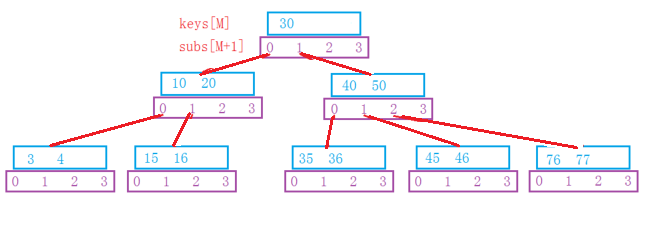B樹屬於多叉樹,也稱多路平衡樹。有些地方也將B樹稱爲'B-樹',這裏‘-’不表示減號。
■B樹的主要性質:
(1)根節點至少有兩個孩子。
(2)每個非根節點爲[[M/2], M]個孩子,這裏[M/2]表示向上取整。
(3)每個非根節點都有[[M/2], M-1]個關鍵字,並且以升序排列。
(4)K[i]和k[i+1]之間的孩子節點的值介於k[i]與k[i+1]之間。(5)所有葉子節點都在同一層。
■下面是一個簡單的3階B樹:
如果想給B樹中,插入一個關鍵字,並且關鍵字的數目超過,且就需要對樹進行調整。那就需要尋找關鍵字的中位數,那怎樣快速的尋找關鍵字呢?
▲思路一:
將所有的關鍵字進行排序,然後將中位數尋找出來。
▲思路二:
利用快速排序的思想,選一個key值,如果左邊個數等於右邊個數,則中位數找到,如果沒有,就在個數多的一邊找出中間位置的關鍵字作爲key值,直到key的左 = 右,則找到關鍵字,這樣的效率更高。
■下面是插入關鍵字示例:
■下面是具體的實現代碼:
#pragma once
//實現B樹(實際就是多叉樹)
/*
性質:(1)根節點至少要2個節點
(2)每個非根節點爲[(M/2), M]個孩子
(3)滿足左孩子值小於根節點,右孩子值大於根節點
(4)並且每個非根節點有[(M/2)-1, M-1]個關鍵字,並且以升序排列
(5)key[i]和key[i+1]之間的孩子節點值介於key[i]和key[i+1]之間
(6)所有節點都在同一層
*/
//實現k形式的結構
//如果要實現K,V結構,就需要創建一個結構體,包括K,V
template <class K, int M = 3> //實現M爲缺省的,值最好取計數,能夠更加方便的求取中位數
struct BTreeNode
{
K _keys[M]; //關鍵字的至多個數,多預留一個位置是可以更加方便的求取中位數
BTreeNode<K, M>* _subs[M + 1]; //孩子節點的最大數目
BTreeNode<K, M>* _parent; //指向父親節點
size_t _size; //數組中存在的有效關鍵字的個數
BTreeNode() //構造B樹節點
:_parent(NULL)
, _size(0)
{
for (int i = 0; i <= M; ++i)
{
_subs[i] = NULL;
}
}
};
template <class K, class V> //需要返回兩個參數,使用結構體
struct Pair
{
K _first;
V _second;
Pair(const K& key = K(), const V& value = V()) //缺省參數,會調用默認構造函數
:_first(key)
, _second(value)
{ }
};
template <class K, int M = 3>
class BTree
{
typedef BTreeNode<K, M> Node;
public:
BTree() //無參構造
:_root(NULL)
{}
Pair<Node*, int> Find(const K& key) //查找
{
Node* parent = NULL;
Node* cur = _root;
while (cur)
{
int index = 0;
while (index < cur->_size) //在一個節點中找相同的關鍵字
{
if (key == cur->_keys[index])
{
return Pair<Node*, int>(cur, index);
}
else if (key < cur->_keys[index])
{
break;
}
else
{
index++;
}
}
parent = cur;
cur = cur->_subs[index];
}
return Pair<Node*, int>(parent, -1);
}
bool Insert(const K& key) //插入節點
{
//沒有節點
if (_root == NULL)
{
_root = new Node;
_root->_keys[0] = key;
_root->_size++;
return true;
}
//判斷返回值
Pair<Node*, int> cur = Find(key);
if (cur._second != -1)
{
return false;
}
//在節點cur中插入key和sub
Node* str = cur._first;
K InsertKey = key;
Node* sub = NULL;
while (1)
{
_InsertKey(str, InsertKey, sub);
if (str->_size < M) //插入後,節點中的數據個數沒有超過規定的
{
return true;
}
//插入數據後,節點的數據個數大於規定的數據個數,需要將節點進行分裂
int mid = (str->_size - 1) / 2;
int index = 0;
Node* tmp = new Node;
//先拷貝key
for (int i = mid + 1; i < str->_size; i++)
{
tmp->_keys[index++] = str->_keys[i];
tmp->_size++;
}
//後拷貝sub
for (int i = mid + 1; i < str->_size; i++)
{
tmp->_subs[index + 1] = str->_subs[i];
if (str->_subs[i])
{
str->_subs[i]->_parent = tmp;
}
}
str->_size = (str->_size - 1) / 2; //更改str的大小
if (str->_parent == NULL)
{
_root = new Node;
_root->_keys[0] = tmp->_keys[mid];
_root->_subs[0] = str;
_root->_subs[1] = tmp;
_root->_size = 1;
str->_parent = _root;
tmp->_parent = _root;
}
else
{
InsertKey = str->_keys[mid];
sub = tmp;
str = str->_parent;
}
}
return true;
}
void _InsertKey(Node* cur, const K& key, Node* sub) //插入key值
{
int index = cur->_size - 1;
while (index >= 0 && cur->_keys[index] > key) //將後面的數據向後移一位
{
cur->_keys[index + 1] = cur->_keys[index];
cur->_subs[index + 2] = cur->_subs[index + 1];
--index;
}
cur->_keys[index + 1] = key; //插入數據及其子節點
cur->_subs[index + 2] = sub;
if (sub)
sub->_parent = cur;
cur->_size++;
}
void InOrder()
{
_InOrder(_root);
}
void _InOrder(Node* root)
{
if (root == NULL)
{
return;
}
for (int i = 0; i < root->_size; i++)
{
cout << root->_keys[i] << " ";
_InOrder(root->_subs[i]);
}
}
protected:
Node* _root;
};
void Test()
{
int a[] = { 53, 75, 139, 49, 145, 36, 101 };
BTree<int, 1023> t;
for (size_t i = 0; i < sizeof(a) / sizeof(a[0]); ++i)
{
t.Insert(a[i]);
}
t.InOrder();
}

